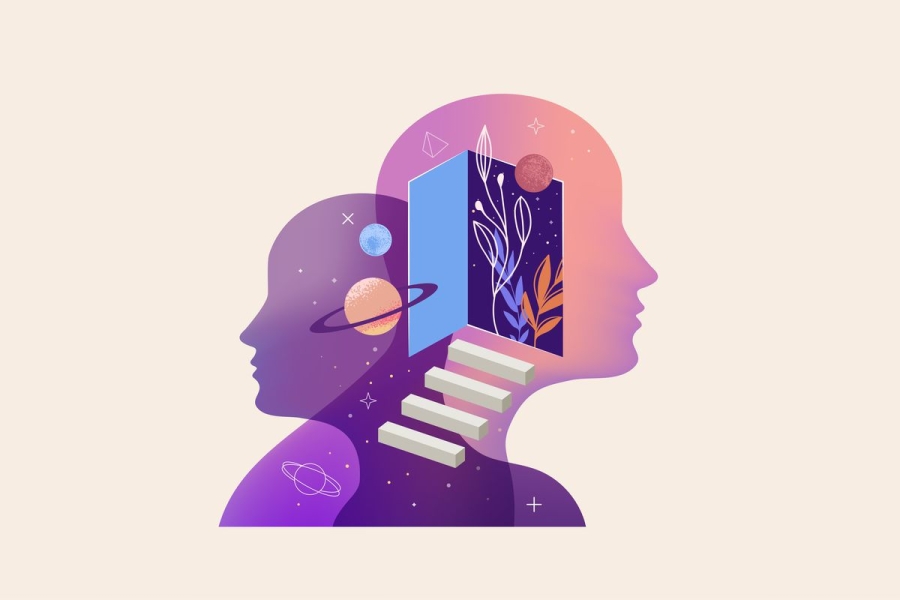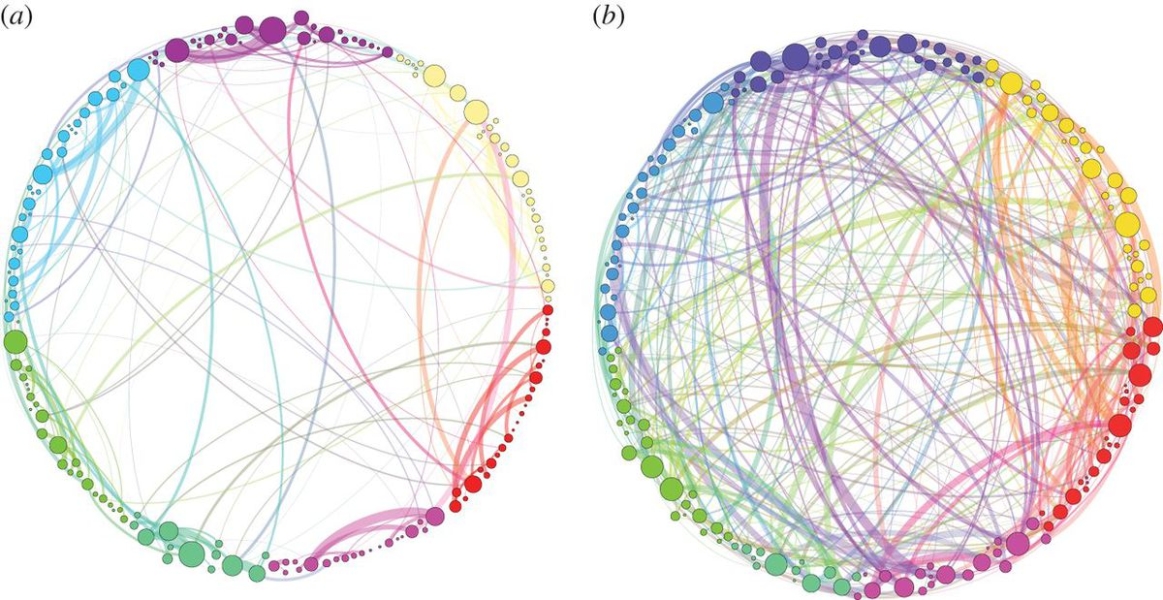Everything seems profound on psychedelics. Scientists are starting to ask why.

Oshan Jarow is a Future Perfect fellow, where he focuses on economics, consciousness studies, and varieties of progress. Before joining Vox, he co-founded the Library of Economic Possibility, where he led policy research and digital media strategy.
In 1882, sitting at his desk with a pen and open notebook, Harvard philosopher William James inhaled a thick cloud of nitrous oxide — better known today as laughing gas, the stuff your dentist uses to numb your mouth.
As the fumes took effect, they bathed his mind in what James called “the tremendously exciting sense of … metaphysical illumination.” What stuck with him after the drugs wore off, though, was not any particular thought — which he soberly conceded as “meaningless drivel” — but the intense feeling of meaning they came packaged in. He called that sense of significance the “noetic quality” of mystical experience.
The noetic quality describes a sensation of encountering revelations of the highest order, where the secret workings of your mind and the world are unfolded before you. But as James also described, these encounters have an elusive quality that makes them difficult to communicate. And through the 20th century, mainstream psychology moved away from nebulous ideas like noeticism and meaning, in favor of variables that were more objective and observable.
Until 2006, when a landmark paper led by the late Roland Griffiths of Johns Hopkins University signaled that research on the profound sense of meaning that accompanies noetic insights was making its way back into mainstream psychology — this time by way of psychedelic drugs.
Griffiths’s study found that, two months after taking psilocybin, the active ingredient in magic mushrooms, two-thirds out of 30 volunteers rated their subsequent trip as one of the five most meaningful experiences of their lives. Further studies that ask the same question have pushed that number to as high as 87 percent of participants, confirming the curious fact that a group of molecules can reliably deliver on demand what the psychiatrist Viktor Frankl called the central human motivation: the search for meaning.
Despite the past two decades of research documenting the tight relationship between psychedelics and meaningful experiences, we still know surprisingly little about what’s actually going on in the brain when psychedelic-assisted meaning sets in. In a paper published earlier this year in the journal Frontiers in Psychology, psychologists Patric Plesa and Rotem Petranker pointed out that even “the best minds in psychedelic research … consistently report that psychedelics enhance a subjective sense of meaning without an explicit theory of meaning.” It’s strange that we lack a mechanical understanding of something so central to a life well lived. If we understood more about the neural mechanics of these bursts of revelation, could we learn anything about how to coax them into our sober lives more often?
The project of developing a mechanical theory of meaning is beginning to take shape. In the past, scientists couldn’t readily observe a nervous system feeling deep meaning. People aren’t generally hooked up to neuroscience gizmos when the noetic experience strikes. But the return of clinical research into psychedelics is making it easier to provoke these elusive states in the lab, and over the past few years, scientists have begun to develop hypotheses on what these drugs could teach us about the neurobiology of meaningfulness.
However, confining the study of psychedelic experience to neurobiology would be repeating an all-too-common oversight in neuroscience of separating the mind from its social and cultural environments, shrinking the study of psychedelic meaningfulness to only what’s happening inside the skull. Subjective experiences — meaningful or otherwise — are shaped by their wider contexts, an insight around which many Indigenous cultures have designed their psychedelic rituals.
And even if we mapped out the precise brain regions that are active during psychedelic boosts of meaning — so what? It’s unclear how much pinpointing the neural correlates of psychedelic meaning will contribute to what matters: learning how to craft more meaningful lives, which is the broader project that has gripped humans since a handful of great religions and philosophies emerged over 2 millennia ago to grapple with questions of meaning, purpose, and significance.
You can’t just trip your way to a meaningful life; that requires more than the mere accumulation of disparate meaningful experiences. In addition, experts suggest that you need a wider architecture, a through line of goals and values that provides coherence and purpose to the narrative arc of your life on the whole. But studying psychedelics to learn more about the biological underpinnings of meaningful experiences could hold any number of fascinating lessons. Instead of providing conclusive answers, psychedelic meaning may reveal profound questions that change the course of action we take in the world.
“Meaning,” Ido Hartogsohn, author of American Trip: Set, Setting, and the Psychedelic Experience in the Twentieth Century, told me, “is valuable not only for therapeutic breakthroughs. It’s helpful wherever we are looking for a way out of our ordinary ways of perceiving and thinking, since it helps us detect hidden paths and possibilities.” Put differently, meaningful experiences, like well-crafted psychedelic trips, can expand our search for how to live meaningful lives.
Serotonin receptors are gateways to psychedelic meaning
Any explanation of how psychedelics are so good at conjuring meaning should include the brain’s serotonin 2A receptors, small proteins dusted across your central nervous system that play a vital role in cognition. Each contains a small pocket, like a landing zone, where molecules of the correct shape can dock. Per the name, these receptors typically receive serotonin, a neurotransmitter involved in a wide range of functions, from mood to sleep. But psychedelics mimic the structure of serotonin, granting them access to the receptor.
In 2017, Katrin Preller, a neuropsychologist at the University of Zurich, published the first experiment to test the specific contribution of these serotonin receptors in the subjective effects of LSD in humans. Participants listened to three kinds of music: music that they found meaningless (often free jazz — no disrespect, Sun Ra fans), music they had preselected as highly meaningful to them, and “neutral” music that was similar to their preselected songs but that they had never heard before.
They listened to each set on three different occasions: once while sober; once on LSD, which, they reported, made all three pieces of music more meaningful; and once on a combination of LSD and ketanserin, a drug that blocks the serotonin receptor so psychedelic molecules can’t dock there. The idea was to see if LSD still produces elevated levels of meaningfulness even when it can’t interact with the serotonin receptor.
The result? Blocking that receptor completely canceled the subjective effects of LSD; participants might as well have been sober. Preller’s findings helped establish that these receptors are critical to the noetic quality. No receptor activation, no extra meaningfulness.
But explaining psychedelic meaningfulness via the activation of serotonin receptors is like saying that turning the keys in the ignition explains what makes a car go. Once the receptors are activated, there’s a whole lot of under-the-hood activity that’s important to understand the mechanisms of meaning.
The brain network that matters

In psychosis research, when people find meaning in what we believe is meaningless happenstance, experts call it “aberrant salience.” It’s a concept that may also shed some light on the psychedelic experience.
Like in bouts of psychosis, psychedelic-induced meaning can be found everywhere and anywhere. It’s no longer dependent on an external trigger that the sober mind would also find meaningful, like the birth of a child. On psychedelics, I could stare at tree bark for three hours, or dirt, or the back of my eyelids, and feel that I’ve discovered the hidden order behind all phenomena. It seems like it’s not particular things that are imbued with meaning, but the whole of perception itself.
“I might call it a misattribution of meaning, where everything gets imbued with a sense of meaningfulness,” Manoj Doss, a research fellow in the department of psychiatry at the University of Texas at Austin, told me. “A lot of times I can attribute the noeticism I’m getting to a memory. We’re usually good at aiming these feelings of knowing. But sometimes they get cut loose. Under psychedelics, I think there’s this misattribution process, where the prefrontal cortex is sending that off in all kinds of different directions where they don’t make sense.”
The psychedelic misattribution of meaning can lead to finding meaning where we ordinarily wouldn’t — like in tree bark. And that noetic feeling can make objectively false insights feel true, as researchers are cleverly finding in the lab. The upshot is clear enough: Psychedelic insights should be treated with a good dose of critical reflection.
Still, looking past whether psychedelic insights are true or not, there remains the question of why they feel so meaningful in the first place. While we don’t know of a brain network specifically responsible for meaningfulness, we do have one that’s pretty close: the salience network, which helps prepare us to take action by prioritizing what stimuli from our environments stick out to us. In other words, the salience network helps determine what matters to us in our perceptual landscape among the flood of information we take in at any given moment.
As Plesa and Petranker explain in their Frontiers study on meaning, we know that psychedelics recalibrate the salience network, altering what appears important to us. In other research on altered states of consciousness, like mindfulness meditation, shifts in the salience landscape are thought to be one of the main mechanisms behind increasing a sense of meaning in life.
It’s possible that a riled-up salience network could explain why anything that falls into psychedelic perception may seem to hold the secrets of the cosmos. Activating the 2A receptor and disrupting the salience network could make everything seem to matter more, functioning as the neural key that opens what the philosopher Aldous Huxley called “the doors of perception.” But Plesa and Petranker argue that the picture is incomplete. There’s another step to get us from the brain mechanisms of mattering to the feeling of meaning: connection.
To get meaning from salience, you need connections
Psychedelics are known to disrupt another major cluster of brain regions: the default-mode network (DMN). The DMN is associated with self-referential thought, like daydreaming about the moment you win the Olympics, or recalling autobiographical memories, like winning the Olympics if you’d actually won the Olympics. It’s the brain’s hub for the narrative self.
Psychedelics reduce activity within the DMN, while increasing activity between the DMN and other brain regions. Christopher Timmermann, a neuroscientist who leads the DMT Research Group at Imperial College London (DMT is a psychedelic drug, like LSD or psilocybin), explained to me earlier this year that “parts of the DMN become hyper-connected with the rest of the brain.”
During interviews after their DMT trips, he said that participants report things like “I was observing the experience, but at the same time I was everything. I was every possible concept in my mind.” Trippy, yes, but it “resonates with this idea of hyperconnectivity,” he said. “These resources we have when it comes to the sense of self become more promiscuous, and become attached to larger systems of meaning.”
Other ways to describe what that hyperconnectivity feels like could be the “connectedness,” “unity,” or “oceanic boundlessness” that often accompanies high-dose psychedelic experiences. Plesa and Petranker believe that the synergy between changes in our salience network and the increased connectedness of DMN disruption could offer the formula that underlies meaning, or an explanation of what happens in the engine after you turn the key.
This is where, as they acknowledge, the car metaphor breaks down. The mind is not a machine. No explanation of conscious states should ignore the social, cultural, and political threads that weave into the tapestry of experience. “It may be that a larger societal prism is required to reconstruct these parts into a coherent narrative,” they write, one that widens its view to include not only the brain but the environments they’re enmeshed in.
Don’t forget the set, setting, and matrix of psychedelic meaning
If you were to jet over to Oregon, the first state to offer legal psychedelic services, the experience would be very different from most Indigenous cultures’ formats of psychedelic use, like the Santo Daime, a Brazilian religion founded in 1930 that uses ayahuasca (a psychoactive brew containing DMT) as a sacrament in psychedelic rituals.

In Oregon’s nascent regulated-use model, you have a preparatory session or two, trip alone (though under the supervision of a facilitator) and indoors, to a playlist while mostly sitting still or lying down, wearing eyeshades. In the Santo Daime tradition, you begin with days of diets, abstinence, and prayer before you touch the drug. The ceremony itself is a group affair with sacred hymns and dancing performed throughout, and can go for eight hours or more.
There’s a huge variety of practices across Indigenous cultures, but each has a very particular “set and setting” that frames the experience. Even in the 1960s American go-round with psychedelics, set and setting were understood as primary parts of the equation for what kind of experience one has.
Even set and setting fail to offer a full account of all the factors that shape psychedelic experiences. The American psychologist Betty Eisner suggested that we think in terms of set, setting, and matrix. The matrix accounts for the everyday environments we’ve grown up in — how our families, societies, economies, and culture have shaped our ideas, expectations, and ways of thinking, all of which play a role in directing psychedelic experience.
By fixing its gaze upon the brain alone, the neuroscience of psychedelic meaning can miss how these wider influences, from a room’s ambiance to a culture’s ideals, can play a direct role in the meaning-making process. “There is always hidden machinery and circuitry that is going on, and we’re not describing it,” the neuropharmacologist Suresh Muthukumaraswamy told Wired’s Shayla Love. “There are all these hidden interactions that, frankly, we’re brushing under the carpet.”
Plesa and Petranker see the past few decades of Western industrialized societies as a troubling context for psychedelic experience — and not just because the prohibition has left us without clear ways of supporting those who experience rare but significant adverse effects. They note the long line of philosophers and sociologists who’ve “warned that life in industrialized, technological societies is undergoing a process of impoverishment of meaning,” and the confluence of rising stress, loneliness, and depression together with the decline of civil society — from religions to bowling leagues.
No matter how strong a psychedelic trip can be, connection remains a critical aspect of meaning-making. Psychedelics may help us forge new connections more easily — but the rest, like designing a society that does the same, is up to us.
Stockpiling psychedelic meaning won’t make for a meaningful life
Let’s say scientists succeeded in mapping the precise neural correlates of psychedelic meaning, and went further, mapping all possible experiences, as the philosopher Robert Nozick imagines in his thought experiment known as the “experience machine.”
The machine could make you feel anything you want. All the while, however, you’d be floating in a womb-like tank with electrodes stuck to your skull, engineering your experience through targeted bursts of electricity.
The experience machine could make you feel untold quantities of meaning — a seamless cascade of one meaningful experience after another. While plugged into the machine, you wouldn’t know it. But every two years or so, Nozick imagined, you’d come out, like briefly waking from a dream, to select your next two years of experiences from a menu.
He saw three main reasons that would drive people to generally choose against plugging into the machine. For one, “we want to do certain things, and not just have the experience of doing them.” Second, we want to be certain kinds of people, not just stagnant bodies floating in a tank. “Someone floating in a tank is an indeterminate blob,” as he put it. And third, the machine limits our experiences only to what human minds, with some added electrical stimulation, can conjure, closing us off to encounters with deeper or wider realities, whether of the natural world, other people, or extradimensional beings.
Whatever the reason, his point is that if you imagine such an experience machine and yet decide you would not want to pass your life plugged into it, you’re proving that something matters to you above and beyond just experience itself. Experience machines are meant as a cautionary tale, and yet already, legal ketamine clinics are halfway to realizing them. Walk into any of the centers scattered around a place like New York City and you’ll find people floating, womb-like, in zero-gravity recliners, wearing eyeshades and earphones that cut them off from other people and the outside world, a ketamine IV pricked into their arms.
The conclusion that something more than just experience matters applies to how we think about the role of psychedelic-assisted meaning, too. It shows that we want to live in ways that generate meaning, not just pump our brains full of molecules that make all experiences meaningful. Researchers have valiantly tried to pin down the multiplicities of meaning, where in addition to experiences of significance and mattering, things like particular aspirations and values that “direct our efforts toward desired futures” factor in.
Working toward particular desired futures calls for taking action in the world, not just modulating brain activity. That means that more skillfully grappling with the crisis of meaning so many of us suffer may call for efforts that change the matrix of everyday life — like, for example, empowering workers to bargain for shorter work weeks, so that they have more of a say in the kinds of lives they may lead, and through them, the kinds of meaning they generate.
To be clear, I think legal access to psychedelic therapy, even within the strictures of a medical model, is good news. But if connection is a crucial part of psychedelic meaning, we may want to reconsider cutting it out of the formal containers in which we legalize access. Focusing only on fostering more connections within the boundaries of a single, atomized brain may undermine the scope of meaning that can be produced.

One implication could be to introduce psychedelic group therapy as a standard practice alongside individual sessions. Or to pursue decriminalization efforts together with regulated access, allowing communities to decide for themselves how they’d like to structure their experiences. “Group therapy should be the norm because it dovetails with the psychedelic mechanism of action,” Plesa and Petranker argue. Allowing for more connectedness — literally, between people — in psychedelic settings could lay the foundation for stronger experiences of meaning, solidarity, and heck, maybe even collective action to emerge.
Another implication is to study psychedelic meaning not just as an ingredient toward therapeutic outcomes but as its own variable of interest. While the so-called psychedelic renaissance has mostly been a matter of therapeutic research, the humanities are starting to formalize their involvement. UC Berkeley’s Center for the Science of Psychedelics and Harvard’s Mahindra Humanities Center recently announced a joint program to study the “humanistic and societal significance of psychedelics.” Christiana Musk, who directs the trust funding the project, added that the value of psychedelics isn’t “limited to their biological effects” but extends into their deep past, as well as potential future, of “cultural development and meaning-making.”
Given the centrality of meaning in human life, psychedelics offer an exciting opportunity to ask new questions, or revitalize ancient ones, of one of humanity’s most enduring and alluring dimensions. But no matter how meaningful a trip, we come down from all highs. What remains as the drugs fade is the everyday world, the set, setting, and matrix for ordinary consciousness, the trip that lasts the longest and matters the most.
Source: vox.com